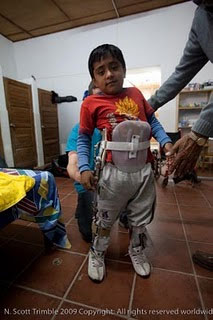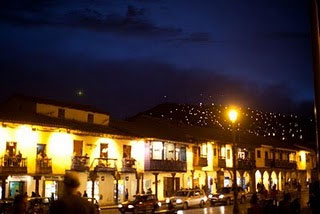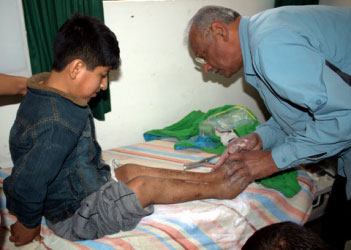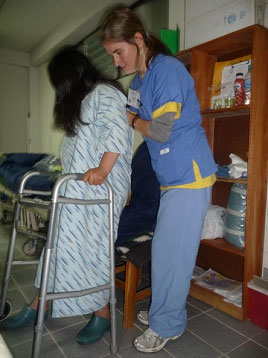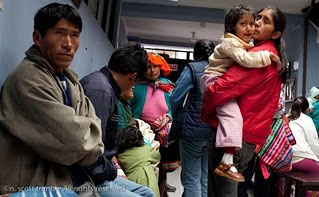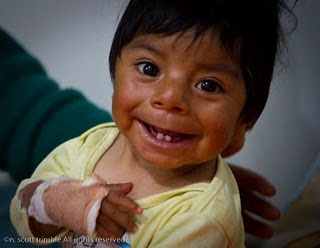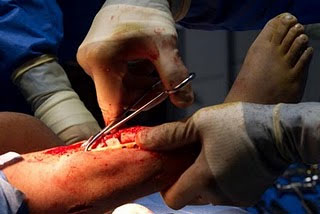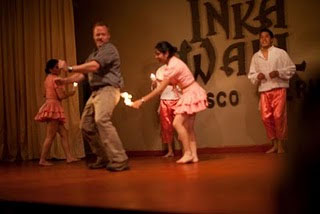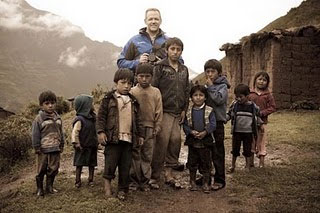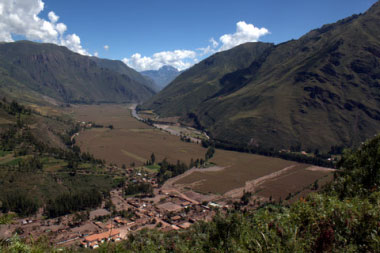
Team Leader: Dr. David Shaw, M.D.
Team Type: Children’s Orthopedics, Prosthetics, Physical Therapy, and Occupational Therapy with Trauma Care Unexpectedly Added
Campaign Summary: This team triaged about 150 children, performed 38 surgeries, fitted around 80 braces, fitted 5 prostheses, and provided physical therapy for about 90 children. In addition to the children treated, the team provided emergency care to 8 victims of a car accident caused by flooding.
Supporters:
Americares — Stamford, Conecticut
One Child at a Time — Salem, Oregon
Team Members:
Stephanie Brenden, Registered Nurse
Vicki Cadwallader, Registered Nurse
Cassie Cooper, Registered Nurse
Jennifer Frydl, Occupational Therapist
Dr. Bill Gallagher, M.D., Orthopedic Surgeon
Dr. Kim Geelan, M.D., Anesthesiologist
Lauren Kjos, Translator
Madeline Nelson, Assistant
Todd Nelson, Prosthetist and Orthotist
Dr. David Shaw, M.D., Orthopedic Surgeon
Andrea Serdar, Physical Therapist
Julie Speck, Physical Therapist
Debbie Sund, Registered Nurse
Scott Trimble, Photojournalist
Lettie Turner, Registered Nurse
Dr. Ted Vigeland, M.D., Orthopedic Surgeon
Dr. Mel Wade, M.D., Anesthesiologist
Kim Wiebe, Registered Nurse
Adapted from N. Scott Trimble’s Blog.
WEDNESDAY, JANUARY 20, 2010
DEPARTING PORTLAND
The plan was to get to the airport early, check everything in straight to Cuzco and relax. In actuality, I met the team with their huge throng of bags full of medical supplies at the airport, but when we got there for the 6 AM flight, the computers were down and there wasn’t a soul at the check-in counter! It turned out that employees don’t come in until 4:30 AM! I learned in Journalism 101 that the first step of any story is to hurry up and wait. This trip seemed to be no exception. Once we got checked in, the flights were uneventful.
THURSDAY, JANUARY 21, 2010
ARRIVAL IN PERU AND DELICIOUS FRUIT JUICE
We arrived in Lima, Peru just after midnight. We did the zombie walk through customs and of course, my bags of attractive camera gear immediately red-flagged me to the bag search area. Fortunately, everything cleared out, so we walked en masse into the common area that was � unexpected.
Ever since 9/11, airports in the U.S don’t allow people waiting for loved ones past a certain point to come in. But even when they did, I don’t remember a flight I ever came in on that had what amounted to a small city crammed in at the security checkpoint like what we walked into. As we walked through, some people would scream and bust out of the line running to family members on our flight to impact them with kisses and hugs and tears of joy. Unfortunately, I didn’t have time to bust my camera gear out of my bags for a few photos. I was warned repeatedly that bags in the Lima Airport have a curious way of disappearing, even when they’re practically attached to you. So opening my cases in a group of over seemingly a 1,000 people wasn’t the wisest thing to do. The only photo I have is burned into my brain.
As we tried to find a safe spot, we met up with our interpreter, Lauren. She’s a 23 year old pre-med student from New York, who met Dr. Shaw a few years ago in Ecuador and has tagged along on many of his missions ever since. We formed a wagon train of bags and fortified ourselves behind them to reduce the chance of the bags growing Peruvian legs and marching off. We broke off in teams to scrounge for food, get massages, make home calls, or just walk off the jet lag. Our flight to Cuzco was delayed from 5:00 AM to 9:40 AM and as a result we were given food vouchers to Dunkin’ Donuts or Mama Morena’s. Some of us felt adventurous and tried Mama Morena’s since doughnuts didn’t suit the rumbling belly. Um � if you ever have the choice, go with doughnuts. Here’s why.
At Morena’s we got dry and suspicious pork sandwiches with stale bread. But that was nothing compared to the juice. We were told they were from cartons, so Todd and I got pineapple and some others got orange. Well, one person who finished the orange juice discovered squirming maggots in the bottom of the carton. This situation incited some squirming from the rest of us. I had already taken a few sips of my juice and sweated the agony to come. I knew better than to select the juice, but it just sounded so good! Most of us slumped into heaps on top of the softest bags we had and made the best of it. If you have a half-body-sized bag, I highly suggest the pose with hands tucked under your back and legs Indian-style lying down. It’s not that uncomfortable!
We got our flight to Cuzco and for some reason I and five other team members scored first class seats for the approximate 1 hour flight. The comfortable, cushy seats eased our minds of the maggot-ridden juice. Luckily, traveling with a medical team has its benefits. Namely, Bactrim! We started a regimen immediately, which didn’t help my nerves when my belly finally started rumbling when we landed in Cuzco.
We departed the plane and met Guido and Sandy Del Prado, co-founders of the Kausay Wasi Clinic in Coya. We drove through the tightly packed ancient looking city that served as the home base of the Inca Empire before Pizarro devastated the area and the people. We passed terraced mountainsides lush with tropical green vegetation and ancient ruins. Coya lies several thousand feet down from 11,000 foot Cuzco in the Sacred Valley of the Incas, a beautiful, amazing place. Our total travel time, including a night in the Lima airport was about 28 hours.
Rumbling stomach aside, we dropped off our bags at the Coya Guest House, the team’s hotel, and we footed it over to the Clinic. Hundreds of parents and children patiently waited for us and we jumped right into triage. Some of the people walked days and days to get a chance to be helped by Dr. Shaw’s medical team. Up and down mountains that would be an unimaginable journey for most Americans to even contemplate.
After triage, Sandy Del Prado, Guido’s wife and native Oregonian, took me across the town square to Martha’s where I was staying. (Since the medical team had overflowed the rooms at the Coya Guest House, I being the only non-medical person, was selected to stay in a different, but nearby home.) The outside of Martha’s home was part of a wall of structures that made up the courtyard. She had a store selling soda and necessities. The inner courtyard had guest rooms on one side and her home on the other. The rooms were quaint, had red and peach walls with a double bed, a little nightstand and wood beams that seemed more like tree limbs.
The shower had a showerhead with an electrical wire sticking out of it connected to a circuit breaker. You turned the circuit breaker and prayed it wouldn’t get wet! Did I forget to tell you that Peru’s electricity runs on 220 volts instead of 110?
It was a little too sophisticated for me to figure out, so I settled for a cold shower. There’s nothing like Andean mountain water. Brrrrr!
Finally I got some real sleep.
FRIDAY, JANUARY 22, 2010
THE FIRST DAY OF SURGERY AND MORE TRIAGE
Under the 40 lbs. of alpaca blankets, I almost never got up. Despite the two hour time difference, I managed to get up at 5:30 AM to a misty morning. Martha, my host, had served bread with jam and coffee for my breakfast.
I was off and running to the Clinic.
Organized Chaos. If I wondered whether I would be twiddling my fingers waiting for something to photograph, I would be hard pressed to find another career choice. The Clinic was packed with parents and children.
The first surgery was a young girl named Elena (not to be confused with Maria Elena later) who was born with fused fingers and really none of them formed past the first joint. She did have thumbs; however, and the team decided to un-fuse the first and second fingers so she could actually grasp things. She might now be able to grasp food, perhaps hold a pen and draw as she manages to do here in this photo.
With everyone including myself finally caught up with sleep – I went to bed at 6:15 PM – A record! The team hit the day with a whopping eight surgeries.
SATURDAY, JANUARY 23, 2010
A DAY OF SURGERY
One patient was named Maria Elena. She is a 23 year old girl who became a critical benchmark for Dr. Shaw’s long list of mission trips. She went in for a hip replacement. The first one he had done on a mission. This procedure is delicate under normal circumstances. Infection can easily set in and create serious problems for the patient. Surgeons often wear environment suits to perform it. In Coya, the doctors had to operate with the minimal supplies they had and foregoed some of the optimal sterilization processes. Unfortunately that meant me NOT being in the Operating Room. I set up a remote camera that I could control with Pocket Wizards, but had problems with interference on the frequency. I finally had to rely on a wired remote cord that would shoot video chips at regular intervals. I got the footage, but a camera bump and lousy camera battery life stopped the filming before the prosthesis was placed. Overall, everyone thought the surgery went well.
Our next patient was Kara, a 4 year old girl born with a club foot. She had had a previous surgery to normalize it somewhat, but today’s surgery would give her pretty much a correct looking foot and most importantly, one that she can use normally. Her surgery was amazing. After the first cuts I saw distinctly the intricate contents of the foot and made sense of the architecture of the bones, veins, muscles, etc. But after 30 minutes of rearranging bones and flushing the tissue, it became indiscernible to me. I realized the true talent of a highly competent surgeon as he decipherable the undistinguishable mass. Kara will have a long recovery in a cast.
Roger is a sweet, happy nine month old born with 12 toes and fingers. He received surgery to remove the extra four digits. In just a matter of hours after surgery, he was happy and bubbly, like nothing ever happened. Babies are absolutely amazing.
SUNDAY, JANUARY 24, 2010
RAIN AND FLOODING
I’ve been trying to wake early to catch the sunrise with those magnificent terraced hills around us, but it’s been an act of futility, as each morning has been met with rain showers. Now, this IS the rainy season, so I shouldn’t be too surprised, but what is typically a sunny day followed by afternoon clouds and evening drizzle, has become an onslaught of showers that threaten the entire region. Since the sky was closed this Sunday morning, I photographed the town square which included a 300 year old Catholic church.
At the Clinic, two children from a Cuzco orphanage were late. The road to Cuzco was blocked by a landslide and threatened all travel to and from Coya. A taxi driver drove me to see the blockage and the rain-swelled river that carves the Sacred Valley of the Incas. My driver took me to the mud hut community his father and cousins live in on some hills on the way to Pisac to get a better view of the river. I could see it was threatening to entirely cut us off from the main route to Cuzco.
We took off to Pisac and saw the water already nearly cresting the banks in town and filling many houses and businesses.
On the way back, we maneuvered around rockslides that swallowed the highway. In Calca, homes were being evacuated. I photographed boys wading across the dangerous river to retrieve their home items. The next day that house would be gone.
MONDAY, JANUARY 25, 2010
HUMANITARIAN MISSION BECOMES AN EMERGENCY ROOM
Continued rains swelled the Urubamba River past dangerous levels, closing the Pisac Bridge and making a return trip to Cuzco several hours longer than normal. The water level reached the power station and shut it down right in the middle of an operation. The generator was kicked on, but Guido and I went to Calca to get more gas and batteries for the Clinic.
We got back and found out the government clinics were closed, so that meant Clinica Kausay Wasi was now the only functioning hospital in the region. Upon our return, we were no longer a medical team helping kids; we were an Emergency Room providing first line care.
Patients rolled in hours after an automobile crash on one of the steep hillsides. A truck carrying 18 people had rolled down an embankment! One person had died. Eight or nine people arrived at the Clinic. One man had a life threatening fractured femur and another had a crushed hip. The crushed hipped man screamed out in pain as the doctors attended to him, while his pregnant wife, who luckily was in another vehicle on its way to her scheduled maternity exam, watched helplessly. A woman with her scalp torn off and fractured ribs shook uncontrollably and another patient endured the torture of having her lips and gums stitched up in the lobby. The serious ones were then sent to a vehicle exchange point at a footbridge to get them to a major government hospital in Cuzco. We later found out that they arrived at the hospital, but waited hours to be seen. Government hospitals work as follows: if you have money, you get seen. If not, maybe never.
It was amazing to see these doctors drop their mission and switch to a mode not in their playbook. The Clinic had an able staff, but the onslaught of medical expertise at hand to help these unfortunate people made a real difference. Today lives weren’t simply changed; lives were saved by their presence here. Heck, even I got to pitch in. When the lights went off, there was nothing in the OR to see by, so I brought in the light panel Micro Pro Photo Supply loaned to me at the last minute to illuminate the room, aiding a critical procedure until the generator started.
Some of us took off to see what the Vicanota (Urubamba) River was doing. People were digging up soil to fortify the levy protecting their homes from the river which was above the home level already.
TUESDAY, JANUARY 26, 2010
SHOULD THE TEAM ABANDON THE CLINIC?
There was mounting concern about the weather and the likelihood that the river above Coya would flood village, including the Clinic. Discussion occurred about the possibility of evacuating to another higher and larger hospital if the rain continued and the river overflowed its banks into Coya. Guido and Dr. Shaw discussed abandoning the rest of the surgeries – about five of them – for fear that they wouldn’t get the proper rehabilitation time. When Dr. Shaw went to the families to discuss the situation, their tears flowed liked the rain outside. Dr. Shaw turned around and told the team all surgeries were on.
I watched “Caros” today walk for the first time in two years. He had been wheelchair bound since a bicycle accident made him a paraplegic. He only had the slightest sensation in his legs. Todd, a prosthetic specialist, and Jennifer, a physical therapist, fashioned a lower body articulated brace with counter lever action and custom fitting. With some help, he was able to stand straight up again and even walked a short distance almost on his own. In the coming months and years, that brace will grow with him and allow him to stand up and read a book, look out a window, and navigate short distances on his own.
We named a patient Coca-Cola, since it was just about all he said. He would light up when he said it. He had spina bifida (incomplete closing of the vertabra over the spinal cord) and needed some hip work. He quickly became a team favorite with the repeated saying of the beverage of choice. However, Vicki Cadwallader wasn’t so sure since her drink of choice was Pepsi. To avoid tension on the team, I tried to get Coca-Cola to say Dr. Pepper. Vicki seemed appeased.
Roosevelt, 14, was born with a congenial disorder that misshaped his lower legs to bow like rainbows – leaving them useless. Doctors Shaw, Vigeland, and Gallagher skillfully sawed and chiseled his tibias like chunks of wood and rearranged them to form a straight leg. Then they used metal plates and pieces of metal that looked like they came from a perfectly preserved erector set to drill them into the diced bones. Their skillful work gave him straight legs to perhaps one day to run with. When his father saw him, he cried for pure joy and so did Dr. Shaw.
A little girl named Nicole came to the Clinic and waited days for a corrective hip operation. Sadly, she will now never have it since she was discovered to have a possible heart murmur as well. Since the Clinic doesn’t have the appropriate monitoring device to say for certain if she did, she and her mother now have to make the arduous day long journey back home, unfixed. Her mother was heartbroken.
This is such a hard place. We take for granted the bounty of services we are used to in the states until we come here. There is a fierce beauty matched with a savage wretchedness. Yet deep green hillsides drape around the region, providing amazing play opportunities for the healthy kids and the ones recovering from their injuries.
When I left dinner tonight at 9 PM, the Coya town square was alive. Children played and yelled and laughed. Tag seemed to be the game of choice tonight.
The Quechuea phrase of the day is Ama whakaichoo – Don’t cry.
WEDNESDAY, JANUARY 27, 2010
SAYING GOODBYE TO MARIA ELENA
Maria Elena walked out of the hospital today.
Sadly, I wasn’t there to see it and I felt really bad about it. Maria Elena had originally been scheduled to leave yesterday, but the floods prevented any taxi’s from her home city of Cuzco from coming then. I did meet her this morning just after she woke up. Her mom was there with her traditional top white hat that reflected her Quechuan background. Maria Elena was a little more contemporary, a trendy red sweater and knit beanie.
It was 10:30 AM and Maria Elena was scheduled to leave, but her taxi didn’t show up. One thirty rolled around and still no show. “It will be here in a few moments” she said. It was becoming a joke since every time I checked on her, “It will be here in a few moments.” was the normal response. But now the team was heading to the cabs. We had a scheduled trip to the city of Urubama to see the market and famed potter Pablo Seminario, known worldwide for his earthenware, and I had to do an interview with the doctors for the day. As much as I hated to do it, because I wanted shots of her leaving in the cab, I had to change my plans. I had footage of her walking out for a breath of fresh air a couple hours before as she was exercising and that would have to do. Via con Dios (Go with God), Maria Elena, we wish you very well. Thanks for teaching me Quechua. Andy, one of the physical therapists, gave Maria Elena a strong workout, a 40 foot walker stroll and a hike up and down the stairs. Her knee was a little swollen on the operated leg, mostly because of the exercise before.
Maria Elena is a special case for Dr. Shaw and Dr. Vigeland. She is the first replacement hip surgery they ever had for a mission like this and I think they are still sweating bullets that no infections manifest. It’s one of the most sensitive surgeries to undertake because if infection does occur, it is very difficult to fight. Typically, such an operation is performed by them using level IV environmental suits in a super sterile environment, but they took every precaution they could since the suits weren’t available.
The patient schedule opened the door for only half day work load today, since the floods prevented many children from coming for treatment and a few kids that would need complicated surgeries wouldn’t have the follow-up from the doctors needed because their operations had been delayed by the power outages the two days prior. So the workload consisted of some cast changes, more physical therapy work, and a few prosthetic and brace modifications. One cast change included Vicki, whose other hip Dysplasia would be approached with cutting off some muscle and connective tissue in hopes of relaxing the ball joint back into the hip instead of the more grueling procedure of forcing it back in like the first hip since it caused more blood loss.
The drive to Urubamba was a slow one. Rock slides completely covered the roads in some spots and the river flowed over others. When we got there, several homes had been washed away and businesses destroyed. People were still working to fortify some areas with soil, building levies to help if the namesake river continued to swell. The pottery gallery was fantastic. My mother is a potter and I think I have some small appreciation for the craft. Pablo and his wife truly made some beautiful work.
We sampled food up and down the narrow market square indulging in the boiled corn on the cob with grape sized kernels. This is the corn that the U.S. usually experiences as Corn Nuts. I have never been a particular fan of Corn Nuts, but as corn on the cob, supremely delicious!
The drivers hastened us back since they didn’t want to be caught after dark on the hazardous roads, so we ended up heading back early. It was 7:00 PM when we arrived and I found out Maria Elena had just left an hour before. She had been waiting nine hours for her taxi and expected a four hour drive back home.
Todd, his daughter Madeline, and I hiked up above the village at sunset, since we got back so early. It was nice we finally got some nature in.
The Quechua word of the day is: iman su tiki? What is your name?
THURSDAY, JANUARY 28, 2010
MAKING THE ROUNDS
High above Coya sits a giant crucifix overlooking the town. Since we arrived in Coya, I have been eager to hike up there, but the rains in the morning and the pitch dark at night have precluded my efforts.
Well, this morning the clouds were absent, except for foggy wisps rising up from the terraced mountain tops. Deep golden arcs were starting to stream up in the east and I know it was now or never to try to get to the crucifix. Martha, my house mom, told me when it dried up enough, she would show me where the trail was to get there. It was still too rough to go by her accounts, but she pointed the finger where, and I met with Todd, Cassie, and Jennifer to find the cross.
We followed a trail leading up past a smaller more primitive community up the hill from Coya. The washout from the river that cut through town revealed how tumultuous it had been. As we climbed up, the path melted into the riverbed and we found ourselves sinking almost up to our knees in mud. We came to an amazingly beautiful home with a fortified wall. We found a huge chasm that the river blasted out, cutting off our chance to get up there, especially with the sun now out and the need to be at the Clinic in 45 minutes. Covered in mud, I got back to my place defeated and to add insult, the water line to the house had been ruptured by the heavy rain lasts night.
I grabbed a bite to eat, thinking of how great I am going to smell today at the Clinic, and voila, the water turned back on. So I was a little late going in this morning!
The rounds were delayed as well since Dr. Shaw wanted to take some pictures with the group and the heavy rain last night. As the rounds were concluded, I said good morning to Vicki, the three-year old double hip dysplasia patient. She immediately snapped her fingers for me to come over and kiss her good morning. She’s plucky and very smart behind those dark wells of eyes. And the smile, when you are lucky enough to get it, (the nurses got pinched and yelled at her more than smiled at, I think) is thankfully the most infectious thing at the Clinic.
She lay in bed with her legs cast in a wide V, which looks to be the most uncomfortable position to be in, especially if you are stuck that way for 6 weeks. I asked her father how long a journey they expect on the way back. He replied that they have a six hour bus ride and a two hour walk. He’ll have to carry her V-legged and all for two hours.
I did some rounds photographing a cast changes and passed through the recovery room where Vicki was. She had some additional guests – their village caseworker and a translator. They wanted to ask me if I would be interested in becoming Vicki’s godfather! I was floored! As a journalist, you try and overcome the Observer Effect, whereby the environment is changed by the existence of the observer who is supposed to be committed to little or no interaction with the environment he is observing. Obviously, my homesickness for my family on this trip swayed my actions to take Vicki and her father under my wing so to speak. Every morning I would come in and check on them, play with her, practice my Quechuan with them, and form a bond. Now they want me as her Godfather.
I was honored, but technically, since I am not Catholic I probably couldn’t truly be her compadre. And when she is scheduled to be baptized next year, the chances I can get back there, and my Protestant background, the priest would probably protest. But it was on of the most touching moments of my life to be asked.
We had another half day and piled up to go way past Urubamba to the Mares Salt Mines an hour away.
The mines are remnants of the Incan Empire, massive terraces of carved salt plots that supplied the Incans for centuries. Now, thousands of families own plots that provide them with their needs, and even a source for high end restaurants around the world. Oh yeah, they are stunning to behold!
That night Guido and Sandy invited us to their home in Calca for diner and drinks. Pisco sours painted the night (a distillate from grapes mixed with lemon juice, egg whites foamed on top, and garnished with bitters.)
To say their house was swell doesn’t even begin to cover it. Casa Grande would be more like it. It is a beautiful property with stunning backdrops. It’s the first place I have ever been I could live at and NOT miss having a TV nearby. Just give me a hammock in the backyard or a comfy spot next to one of the many fireplaces in every room and a good book (forget the pisco sour) and I am gooooooddd.
I nailed Guido down for an interview with the jagged peaks as a backdrop. You really have to respect a man who holds nothing back. Guido is really passionate about the work his Clinic does and he has little tolerance to whatever might impede it. Afterwards, we had the best meal on the trip – roasted chicken with delicious seasoning. I couldn’t even figure out the seasoning, (which is pretty hard to stump me) and mmm – French fries!
The Quechua word of the day is: Titanchise Kanwan – good luck.
FRIDAY, JANUARY 29, 2010
THE LONG(ER) ROAD TO CUZCO
Today was our last day at the Clinic. Once again I woke up to another rainy day. I jumped in the shower. Today I made the mistake of stretching and grazed my head across the shower head and completed the circuit that formed from the bare wires connecting it to warm water and my wet feet.
Needless to say, I didn’t need Martha’s coffee this morning to wake me up.
Martha met me downstairs and asked me in the most English words she had managed to string together since I met her “Would you like to see my cuy?” I didn’t know what to think. Turns out, cuy is the regional delicacy here – Guinea pig! Martha took me to the storage room where 50 or more guinea pigs huddled in the corner waiting to become fried on a stick!
Vicki was back to her sparkly self and Luis Elvis, a young boy who had to have a triple lateral club foot correction, was in good spirits. Today was the day they got to go home. In the other room, Roosevelt bravely gave a smile, hiding the pain he felt from his wood sawing-like procedure. I interviewed Roosevelt and his dad about why he wanted the surgery so bad. Roosevelt simply stated he just wanted to be able to cross a room without bumping into things and being laughed at by the other kids. Wow! If there ever was a statement to bring home why the members of this medical team do what they do, it was right there.
Everyone packed up their things – surgical instruments, packing supplies, unused orthopedic hips. It was time to go. We packed up three vans of people and bags and left Coya behind us. Well, except for the parts that will always stay with us.
We went to Pisac for lunch, but Cassie, Todd, Madeline and I opted to see the Pisac Ruins, a massive Inca City that rivals in size to Machu Picchu. We didn’t have time to see the whole thing, so we broke out the Griswald Family rush to probe as far in we could and rush back. Not an easy thing with something this beautiful and high up. You’d think we were chain smokers who just finished a bacon buffet the way we were gasping from a 50 yard jog downhill.
Since the Pisac bridge was washed out, the 40 minute drive to Cuzco (Qos’qo in Quechuan) stretched to over two hours. The landscape was beautiful. Billowy clouds floated above and the sun ignited the velvety green carpet that draped the hillsides. We rose above the terraced mountains to grassland meadows, the higher, jagged, snow covered Andes tops now revealed.
At first impression, Cuzco seemed like a Baroque inspired crowded, polluted city. But as you peel past the outer layers, the Inca ancestry of the architecture (theirs were the masterfully cut stone walls, the Spanish built the mortared ones) and the Beautiful Plaza de Armas revealed why it is considered one of the most beautiful cities in the Americas. At night, as I stood in the plaza, it was hard to look straight up at the constellation Orion and drop your gaze to focus on the cityscape. The pinpoints of light that dot the hillsides are almost indistinguishable from the stars above.
Several of us went to one of the tourist favorite pubs and downed the coldest beer I think I have ever had. Maybe it was just weariness from having warm drinks and cold eats, but this was definitely a degree away from ice crystals, and my palate was very pleased! We ate traditional Andean food that served everything from cuy to alpaca. (Alpaca tastes like steak.) We also watched a traditional dance presentation at which I got pulled up to show off my unflattering dance moves and my bottom set on fire – apparently some courting ritual dance. Oh well, at least it entertained the team!
SATURDAY, JANUARY 30, 2010
HOMEBOUND
The trip back home was a daunting one. The layovers were the killer – an overnight stay in Lima’s wonderful airport (yes, we stayed away from Mama Morena’s), but I did catch up on some editing and a few shopping items for my daughters.
I couldn’t help but reflect on the 10 day trip, which seemed to age me far more. We forget what the rest of the world goes though when we are insulated with our TV’s, our water heaters, and our problematic, but still superior health care in the U.S. I hope some big changes can happen here so we can have better access to the talents of people like Dr. Shaw and his team. But having seen what Peru has to face on a day to day basis when teams aren’t there giving up their free time, we should count ourselves lucky.
The Quechua word of the day: Tupananchiscama – Goodbye, until we meet again.










